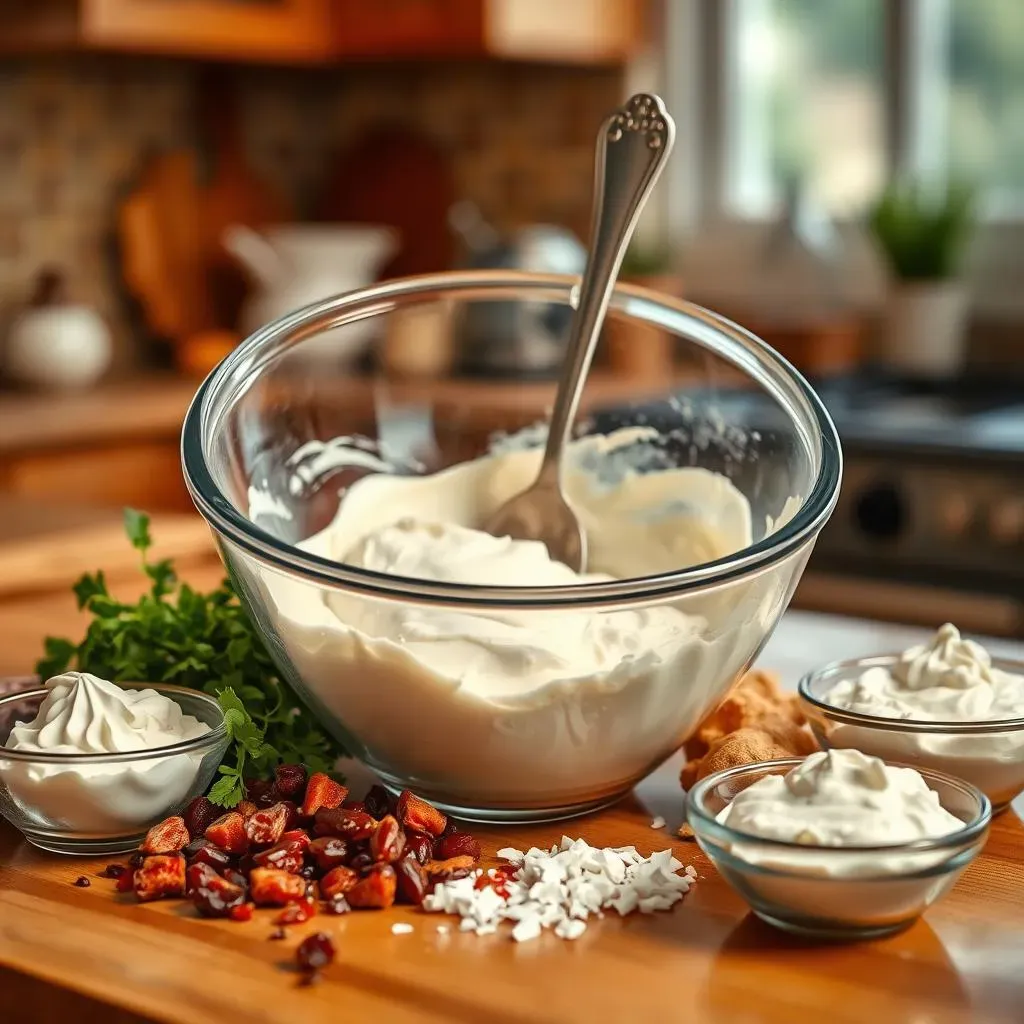Table of Contents
Ever found yourself mid-recipe, staring at an empty sour cream container, while a lone tub of yogurt chills in the fridge? It's a baking dilemma many of us face: can you substitute yogurt for sour cream in baking? The good news is, often, the answer is a resounding yes! But, like any good kitchen hack, there are nuances to understand. This article isn't just going to tell you "yes, you can," and leave it at that. We'll explore the science behind why yogurt works as a substitute, where it shines, and where you might want to think twice. We’ll look at different types of yogurt, like Greek and regular, and how they impact your baked goods. We’ll also cover some tips to ensure your substitutions are successful, so you can bake with confidence, even when you're out of sour cream. So, grab your apron, and let's get to the bottom of this creamy conundrum!
The Great Yogurt vs. Sour Cream BakeOff: Can You Substitute Yogurt for Sour Cream in Baking?

The Great Yogurt vs. Sour Cream BakeOff: Can You Substitute Yogurt for Sour Cream in Baking?
The Big Question: Can They Really Swap?
Okay, so you're staring into your fridge, recipe in hand, and the sour cream's MIA. We've all been there. The question of “can you substitute yogurt for sour cream in baking?” isn't just a random thought—it's a real-life baking emergency! The short answer? Yes, often you can. They're both tangy, creamy dairy products, but their differences are crucial. Think of it like this: they're cousins, not twins. They share some family traits, but they each have their own unique characteristics that affect baking.
Sour cream is known for its rich, thick texture and distinct tang. Yogurt, on the other hand, can vary wildly. You’ve got the thin, regular kind, and the super thick Greek yogurt. These differences in fat content and consistency are what make the substitution game a bit more complex. So, it's not just a simple one-for-one swap in every recipe, but it's definitely doable with a little understanding of how they behave. Let's start to understand their personalities!
Understanding the Players
Before we get into the nitty-gritty of swapping, let’s get to know our main players. Sour cream, with its higher fat content, lends a rich, dense texture to baked goods. It also adds a certain tang that helps to balance sweetness. Think of it as the indulgent, slightly sassy cousin. Yogurt, on the other hand, is a bit more of a chameleon. Regular yogurt is thinner and has a milder tang, while Greek yogurt is thicker and tangier, thanks to the whey being strained out. The key to successful substitution is understanding these differences in texture, fat, and tang.
It's not just about throwing any old yogurt into the mix. You need to be strategic. Are you making a light and fluffy cake? Or a dense and moist muffin? The type of yogurt you choose, and how you use it, will make all the difference. So, before you start pouring, let's break down the strengths and weaknesses of yogurt when it steps into sour cream's shoes.
Feature | Sour Cream | Regular Yogurt | Greek Yogurt |
|---|---|---|---|
Fat Content | Higher | Lower | Variable, often lower |
Texture | Thick, rich | Thin, smooth | Very thick, creamy |
Tang | Distinct | Mild | Stronger |
Yogurt's Strengths and Weaknesses When Baking Instead of Sour Cream

Yogurt's Strengths and Weaknesses When Baking Instead of Sour Cream
Yogurt's Strengths and Weaknesses When Baking Instead of Sour Cream
So, yogurt's stepping into the baking ring, ready to replace sour cream. But, it's not a perfect clone, right? Let's break down its strengths. First off, yogurt, especially Greek yogurt, is a protein powerhouse. That can actually help create a softer crumb in your baked goods. It also adds moisture, which is a big win if you're trying to avoid dry, crumbly cakes. Plus, that signature tang can add a nice zip to your recipes, similar to sour cream, but maybe a bit less intense. It's like the friendly, slightly less dramatic cousin that still brings the flavor.
However, it's not all sunshine and rainbows. Yogurt's lower fat content, compared to sour cream, can sometimes lead to a slightly less rich final product. It might not give you that same luxurious mouthfeel. Also, the higher water content in regular yogurt can sometimes make batters a bit too thin, which can affect the texture of your baked goods. And, if you're using flavored yogurt, well, that's a whole other ball game, and it's not going to replace the tang of sour cream, not at all. So, while yogurt has some great qualities, it also has some areas where it might fall a bit short if you're not careful. It's all about knowing its limits and working around them.
Here are some pros and cons to keep in mind:
- Pros:
- Adds moisture
- Provides a softer crumb
- Offers a tangy flavor
- Good source of protein
- Cons:
- Lower fat content can affect richness
- Higher water content can thin batters
- Flavor variations can be unpredictable
How to Substitute Yogurt for Sour Cream Effectively

How to Substitute Yogurt for Sour Cream Effectively
How to Substitute Yogurt for Sour Cream Effectively
Alright, so you're ready to swap that yogurt for sour cream, but you want to do it right, right? Here's the deal: the key is all about adjusting. If your recipe calls for a cup of sour cream, and you're using regular yogurt, you might want to start with about ¾ of a cup. The thinner consistency of regular yogurt means you don’t need as much to get the same moisture level. If you're using Greek yogurt, which is thicker, a one-to-one swap is often fine. But, remember, Greek yogurt is tangier, so if you're worried about an overly tangy taste, you might want to start with a bit less, and add a splash of milk or water to loosen it up if needed. It's like a science experiment in your kitchen, but the results are usually delicious. And hey, a little tweaking is always part of the fun, isn’t it?
Another important point is the fat content. Sour cream's high fat is what gives baked goods that rich texture. Yogurt, especially non-fat or low-fat varieties, is missing that. To compensate, you might want to add a tablespoon or two of melted butter or oil to your batter, especially if the recipe is a cake or something that needs a bit of extra richness. This isn't a must, but it can help to achieve a similar result. And remember, if the recipe needs a lot of tang, and you're using a mild yogurt, you can add a tiny bit of lemon juice or vinegar to boost that flavor. It is all about balancing, think of it as you are trying to find the perfect harmony in your recipe. Baking is an art, and sometimes you just need to paint with a few extra strokes!
Yogurt Type | Substitution Ratio | Notes |
|---|---|---|
Regular Yogurt | ¾ cup for 1 cup sour cream | Reduce liquid in recipe if needed, add a bit of fat. |
Greek Yogurt | 1:1 ratio | May need to add a splash of liquid to thin, watch the tang. |
When to Think Twice Before Using Yogurt Instead of Sour Cream in Baking

When to Think Twice Before Using Yogurt Instead of Sour Cream in Baking
When Richness is Key
Okay, so we've talked about when yogurt is a baking superhero, but let's be real, sometimes it's just not the right fit. If a recipe hinges on that super-rich, melt-in-your-mouth texture, like a super decadent chocolate cake or a super creamy cheesecake, swapping sour cream for yogurt might leave you feeling a little disappointed. Sour cream's high fat content is what gives those recipes that luxurious feel, and yogurt, even Greek yogurt, just can't quite replicate that. It's like trying to replace a velvet curtain with a linen one – both cover the window, but they bring different vibes. So, if the recipe description uses words like "indulgent," "decadent," or "ultra-creamy," you might want to stick to the sour cream. It's not worth the risk of a less satisfying bake.
Think of it this way: sour cream is like the butter of dairy, it's rich, full of fat, and brings a certain level of decadence to recipes. Yogurt is leaner, a bit lighter, and while it can be a great substitute, it won’t always give you the same outcome. If you are making a simple muffin, yogurt is fine, but if you are trying to make a birthday cake, perhaps sticking with sour cream is the right choice. It is all about choosing the right ingredients for the job.
The Tang Factor
Another thing to consider is the tang. Yes, both sour cream and yogurt have that lovely tartness, but they’re not the same. Sour cream has a distinct, almost savory tang that can really balance out sweetness in baked goods. Yogurt, on the other hand, can be a bit more variable. Regular yogurt is milder, and even Greek yogurt can have different levels of tang depending on the brand. If the recipe relies heavily on that specific sour cream tang, like a classic sour cream coffee cake, a yogurt substitution might not hit the mark. You might end up with a cake that just doesn't have the same depth of flavor. It's like trying to play a sad song on a happy instrument – it just doesn't quite work.
Consider the flavor profile of the dish. If it's a recipe where the tang is a key element, then yogurt might not be the perfect sub. It might alter the taste and aroma of your baked goods. It might be better to use sour cream instead if you are aiming for a specific type of tang. It is essential to understand how the tang works in your recipe.
Recipe Type | Sour Cream | Yogurt |
|---|---|---|
Rich Chocolate Cake | Preferred | May lack richness |
Classic Cheesecake | Preferred | May alter texture |
Sour Cream Coffee Cake | Preferred | May not have same tang |
Simple Muffins | Okay | Good substitute |
When Flavors Clash
Finally, let's talk about flavored yogurts. While they might seem like a convenient option, they can throw off the entire flavor balance of your recipe. Using a strawberry yogurt in a lemon cake? Not a good idea. It's like trying to mix two different songs together, it can be a little chaotic. Flavored yogurts have added sugars and artificial flavors that can overpower the other ingredients in your recipe, and you might end up with something that tastes nothing like you intended. Plus, they often have a thinner consistency, which adds another layer of complexity to the substitution. So, unless you’re intentionally going for a flavor mash-up, it's best to stick with plain, unflavored yogurt for baking. It’s always better to use plain yogurt and add your own flavors, this way you can control the results. Think of it as using a clean canvas to create your masterpiece.
It's always better to err on the side of caution when it comes to baking. If you are not sure how a substitution will impact your recipe, it is better to stick with the original ingredients. Baking is a science, and while you can experiment, it is essential to understand the basics before you start changing things up. It is all about making informed decisions.